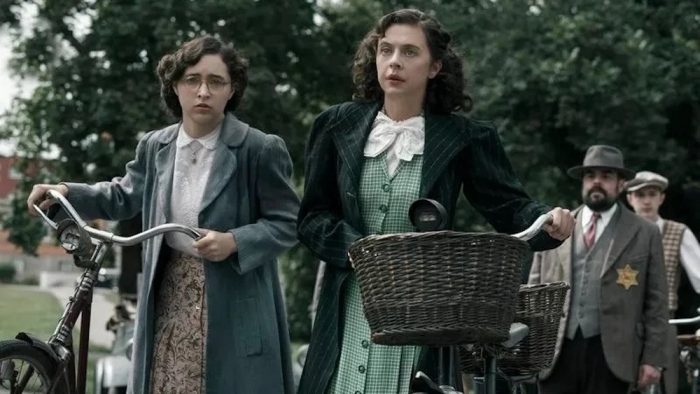The woman who hid Anne Frank takes center stage in ‘A Small Light’
Reviewed by Jeffrey Sanzel
‘But even an ordinary secretary or a housewife or a teenager can, within their own small ways, turn on a small light in a dark room.’ — Miep Gies
No figure is more iconic than Anne Frank. Whether seen as an ordinary girl in extraordinary times, or a remarkable individual robbed of her potential, her short life and terrible death epitomize the darkest era of the twentieth century. And while her memory transcends decades, she should be remembered as a person with hopes and aspirations, feelings, and foibles. Anne Frank was not a symbol; she was a human being.
The Diary of a Young Girl—often called The Diary of Anne Frank—appeared in its original Dutch in 1947. The first English translation, Anne Frank: The Diary of a Young Girl, was published in 1952.

The diary was given to Anne as a thirteenth birthday present on June 12, 1942. She chronicled her life in this book and two school exercise books. On March 29, 1944, she listened to a London radio broadcast by the exiled Dutch Minister for Education calling for the preservation of “ordinary documents … simple everyday material” as a testimony to the plight of Dutch civilians under the Nazi regime. She began revising the entries with this in mind. Her final entry was on August 1, 1944, three days before her arrest and deportation. Miep Gies and Bep Voskuijl, two of the brave people who helped hide the Frank family, saved the loose pages of the manuscript. After the war, they gave the papers to the only surviving occupant of the attic, Anne’s father, Otto.
A stage adaptation premiered on Broadway on October 5, 1955. Adapted by Frances Goodrich and Albert Hackett (supposedly handpicked by playwright Lillian Hellman), the well-received production emphasized the hopeful aspects, highlighting (but perhaps ignoring true context) the signature quote: “Despite everything, I believe that people are really good at heart.”
In 1959, this version was brought to the screen in the equally lauded version. It was not until 1997, when Wendy Kesselman revised and re-envisioned the play, there was an Anne Frank properly representing the true darkness and struggle, divesting itself from the earlier incarnation’s occasional saccharine. The BBC produced a television film in 2019 with an entirely new script.
Of the cinematic incarnations, the most powerful is Anne Frank: The Whole Story (2001). Due to a conflict between the producers and the Anne Frank Foundation, the creators were denied access to quote Anne Frank’s writings. Instead, according to producer David Kappes (in a private interview), the ninety-year-old Miep Gies was used as a primary source to tell Frank’s history. (Gies passed away in January 2010 at 100.) This account takes Anne beyond the annex, following her through deportation to the Westerbork transit camp, transport to Auschwitz, and finally, her death in Bergen-Belsen.
Gies told her story in the memoir Anne Frank Remembered: The Story of the Woman Who Helped to Hide the Frank Family (1987). Subsequently, she was featured in the Academy Award-winning documentary Anne Frank Remembered (1995).
[The following is based on a viewing of the first two episodes of A Small Light.]
Now, National Geographic has produced A Small Light, an eight part miniseries streaming on Disney+ and Hulu. This begs whether there is a need for another screen version of the story. If it is A Small Light, the answer is a resounding “yes.”
Masterfully directed by Susanna Fogel (from a screenplay by Tony Phelan, Joan Rater, William Harper, and Ben Esler), A Small Light takes Miep Gies from the sidelines. It presents her center in a wholly realized and beautifully dimensional account. The series is an inversion of previous Anne Frank stories. Rather than the claustrophobic fear of being surrounded by the horrors of the outside, this is the terror of living day-to-day in a world with danger at every corner and every turn.
Episode one opens in 1942. Miep Gies (Bel Powley) bicycles with a frightened Margot Frank (Ashley Brooke) through the streets of an idyllic Amsterdam festooned with Nazi banners interspersed with “Resist” graffiti. Miep is attempting to get Margot through a Nazi checkpoint. The scene is taut, tense, and done in quick, sharp cuts.
Before they reach the front of the line, the action shifts back to 1933. After a night of drinking, Miep joins her large, adopted family for lunch, having slept until 2 p.m. Her frustrated parents suggest that if she cannot find a job, she marry her adopted brother (who, unbeknownst to his parents, is gay). Miep lives a leisurely, almost bucolic life.
After an awkward interview, Otto Frank (Liev Shreiber) engages the unskilled Miep as a secretary. Brash and temperamental, she still learns the business and begins to find her place in the organization. Life goes along with Miep meeting her eventual husband, the shy Jan (Joe Cole), in a bar.
On May 10, 1940, the Nazis invaded the Netherlands. Within five days, they had taken over the country. Laws change, and the harsh Nazi abuse transforms into greater crimes. (It is not until the middle of episode two that we see the brutality of the round-ups.) The infamous yellow star appears on clothing.
Eventually, Otto shares the plan of taking his family, along with his employee Hermann Van Pels’ family, into hiding and asks for Miep’s help, to which she immediately agrees. However, Otto changes the moving date when his older daughter Margot receives deportation papers. The first episode returns to the opening scene as Miep gets Margot through the checkpoint and into the annex, the first glimpse of the hiding place.
The second episode shows the earliest days of the new life. On the inside, attitudes are already fraying as the Franks attempt to adapt. Miep must deal with the already frustrated and often frustrating individuals living like prisoners. She also faces the challenges of keeping the secret as well as finding food, ration books, etc. Husband Jan aids Miep but also begins his own journey to help the persecuted. This episode ends with the dentist, Fritz Pfeffer (Noah Taylor), completing the members of the attic.
The cast is uniformly exceptional. Liev Schreiber makes for a slightly mercurial but effective and compassionate Otto. Amira Casar’s Edith Frank is a stronger, more demanding Edith. Billie Boullet is an exceptional Anne, shining and passionate but grounded in reality. Ashley Brooke hits the right gentle notes as the reserved Margot. Joe Cole grows Jan throughout, going from reticence to strength with a charm that comes through.
But the center is Bel Powley’s exceptional Miep. She grows from the lackadaisical party girl and reluctant employee to a ferocious, committed portrait of real courage. Whether flirting with a butcher to get a better chicken or resigned to revealing the true situation outside the attic walls, her reality and depth are flawless.
From an educational standpoint, the series is invaluable. The current curriculum rightfully deals with turning bystanders into upstanders and changing the bullying narrative. Miep Gies reminds us never to stand by; as individuals, we must choose to make a difference. We must do more and must do better. For that alone, her story is beyond important. The fact that A Small Light is art presented with raw integrity elevates the message to a higher level.







